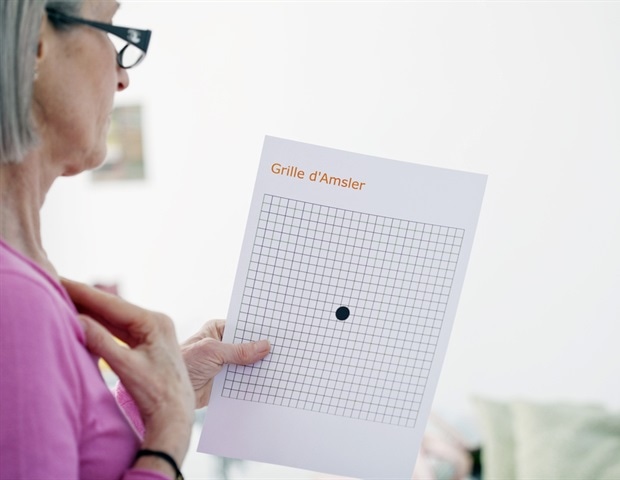
The California Institute for Regenerative Drugs (CIRM), the state’s stem cell company, has awarded a two-year, $6 million grant to a group on the USC Dr. Allen and Charlotte Ginsburg Institute for Biomedical Therapeutics and the USC Roski Eye Institute advancing a brand new therapy for one of many main causes of blindness in older adults. The funding will allow the researchers to conduct preclinical research wanted earlier than launching human trials.
The investigators intention to speed up progress in preventing dry age-related macular degeneration (AMD), which impacts about 16 million folks within the U.S. The illness is rooted in harm to the attention’s retinal pigment epithelium (RPE), the cells that help the photoreceptors of the retina. RPE cells shield, feed, and restore the rods and cones that convert mild into alerts readable by the mind. Dry AMD, which generally manifests in folks 50 and older, is at the moment incurable and might finally render these struggling legally blind.
Remedy choices are presently restricted to well-established vitamin dietary supplements and newly emerged immune-regulating therapies, each of which may solely gradual the development of dry AMD. The USC technique supported by CIRM takes a completely completely different strategy -; an injection containing a combination of the restorative, anti-inflammatory and antioxidant compounds which might be launched by stem cell-derived wholesome RPE.
Nothing that is at the moment on the market halts or reverses the illness, and plenty of sufferers find yourself progressing to blindness. There is a want for a brand new strategy. If we will develop this injection and cease illness development or really enhance imaginative and prescient, that might be wonderful from a affected person perspective.”
Mark Humayun, MD, PhD, principal investigator, College Professor of Ophthalmology and Biomedical Engineering and holder of the Keck Faculty of Drugs of USC’s Cornelius J. Pings Chair in Biomedical Sciences
The RPE secretions had been derived from one other dry AMD therapy developed by Humayun and his colleagues. The unique remedy, which can quickly enter mid-stage scientific trials, is an implantable patch of RPE cells grown from stem cells that’s being commercialized by Regenerative Patch Applied sciences. When the researchers discovered that the patch was serving to retinal cells far past its borders, they began wanting into the results of the fluid launched by the patch (i.e., the secretome).
CIRM help, starting in 2010, enabled the patch to maneuver from preclinical growth to scientific trials. Constructing on that success, CIRM funding then allowed the group to fastidiously examine the promising results of the RPE secretome, ensuing within the new CIRM grant meant to once more bridge analysis from the laboratory to early-stage exams in people.
“CIRM has been extremely vital to this work,” stated Humayun, who’s the co-director of the USC Roski Eye Institute and director of the USC Ginsburg Institute for Biomedical Therapeutics. “All of this was made potential by CIRM help. California is admittedly main the best way in stem cell analysis for a bunch of well being challenges because of California public funding.”
The forthcoming analysis funded by the stem cell company positive aspects momentum from different steps already taken to fast-track the brand new therapy for scientific trials. The investigators have had a collection of preliminary discussions with the Meals and Drug Administration (FDA) and have recognized companion testing and manufacturing amenities licensed to comply with good practices regulated by the FDA.
The brand new remedy is supposed for intervention at earlier levels of dry AMD. It might play a complementary function with the patch, which addresses superior dry AMD.
“Basically, we get two pictures on aim from the identical product,” Humayun stated. “If we’re profitable, we will cowl sufferers from A to Z within the continuum of their illness.”
He emphasizes the significance of one other key ingredient -; cross-disciplinary collaboration. Bioengineers from the USC Viterbi Faculty of Engineering can be important to the event of the patch, and Humayun will enlist USC Viterbi specialists in synthetic intelligence to maximise the therapeutic potential of the secretome from stem cell-derived RPE.
“There are such a lot of combos and permutations for the genetic knobs and levers we will use, it could take perpetually in the event you simply tried them sequentially,” he stated. “The engineering enter is important. AI will assist us higher perceive refine and enhance this remedy. And as a ‘college of faculties,’ USC gives a singular tradition and surroundings for these kinds of interactions between disparate fields.”
Humayun, a recipient of the Nationwide Medal of Know-how and Innovation, has already constructed an unusual observe report of success in bettering care via his analysis. He’s the lead inventor of the Argus II -; often known as the “synthetic retina” or the “bionic eye” -; a tool that has restored restricted imaginative and prescient to lots of who had been beforehand blind since its FDA approval in 2013.
For this physician-researcher, the prospect of increasing the advantages he has created for sufferers is thrilling on a number of fronts. He is aware of the toll of blindness all too effectively; his grandmother, who helped increase him, finally misplaced her sight.
“There isn’t any different feeling fairly like when you’ll be able to assist restore sight to any individual who’s blind,” Humayun stated. “Professionally, you’ll be able to’t ask for something extra. And on a private observe, it’s deeply impactful for me given every thing my grandmother meant to me.”
Supply:

